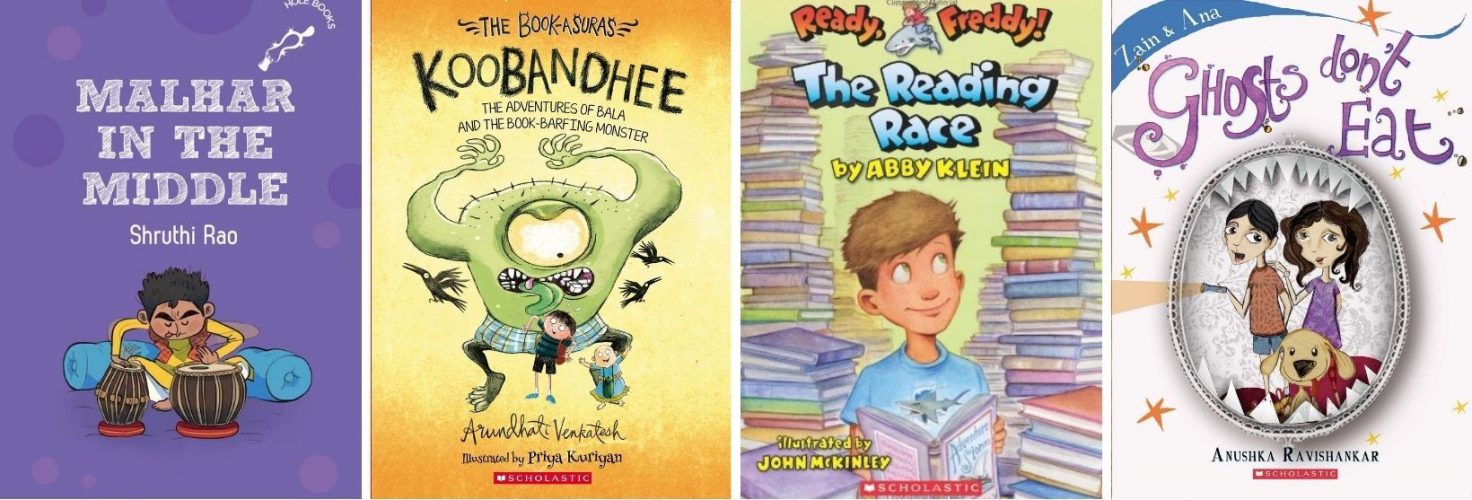

January 11, 2023
I read The Amazing Story of Adolphus Tips several years ago. And like most of Michael Morpurgo’s books, it’s a classic. In the cruellest, most inhuman of times, we find stories of courage and love – Morpurgo never fails to remind us of that.
Through a series of diary entries, we learn about 11-year-old Lily, who lives in Slapton in 1943. The war seems very far away, even though several “townies” now study in the same school as Lily. Life goes on as usual–until the people of Slapton are told they must evacuate in seven weeks. Lily’s grandfather refuses to move, but the time comes when he accepts that he will help the war effort by moving, so he does. The problem is that Lily’s precious cat, Tips, goes missing, and everyone begins to hunt for her, including the Yankee soldiers who are now in Slapton.
As the hunt for Tips goes on, relationships are formed, and these relationships drive the story, leading to the astonishing end of the book, one that fills us up and makes us rejoice.
The Amazing Story of Adolphus Tips is a beautiful, heartwarming story – I can’t wait to share it with my book club!
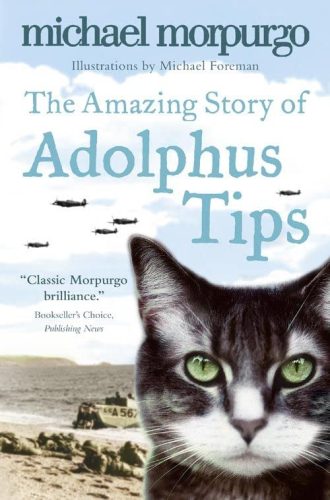
Lily renames her cat Adolphus Tips after the soldier Adolphus, whom she meets in Slapton. Whom would you name an animal after, and why? What about toys? Have you ever named a toy after someone?
The story of Adolphus Tips is revealed to us through Lily’s diary, the perfect prompt for us to write a journal entry or two. We will begin by writing a little about ourselves – our day, and what makes it special. We will then move on to a more imaginative entry–about a day when we have to move out of our home to a new place.
We learn about Tips’s adventures through Lily, but what if Tips could write for herself? What would her diary look like?
REGISTRATIONS ARE NOW CLOSED FOR THIS EDITION OF READ, WRITE, EXPLORE.
New batches begin every alternate month. If you would like to receive email notifications about my programmes, please fill this form. Alternatively, follow me on social media – Facebook, Instagram and Twitter – for regular updates.
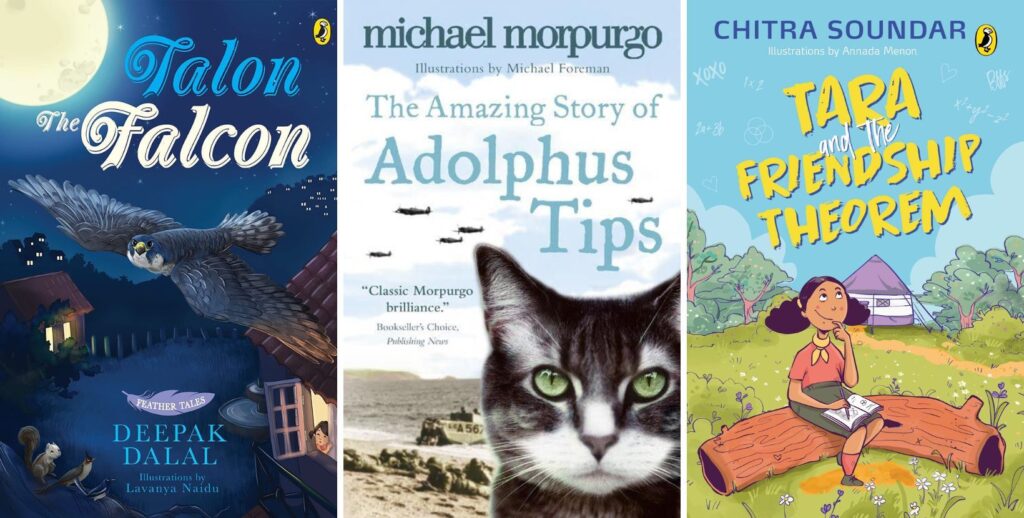
January 10, 2023
What child has never dreamed of being a detective?
The Egghead Detective Agency is perfect for my book club in so many ways. For one, there are clues to solve within each story. For another, the characters are young children, accompanied by a friendly ghost, making the book fun to read. I enjoyed the cases too – raining cupcakes, a missing chicken, a pink pool and more!
Here’s what we’ll do as we read the book together.
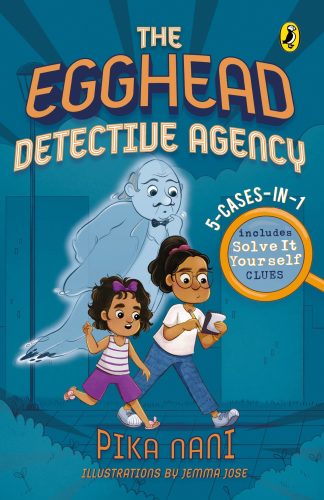
Can we all become detectives? We’ll begin by trying to solve the clues in the stories, but we’ll move on to observing the world around us. What unusual things do we notice the moment we pay attention? A mark on the wall? A strange smell? Good detectives are, first, good observers!
Many children are familiar with Enid Blyton’s wishing chair. Here, in The Egghead Detective Agency, we have another kind of magical chair – one in which a ghost appears. Can we imagine something new? What else could a magical chair do?
Story worksheets are always fun, and a set of detective stories provides us with the perfect opportunity to write a mystery story of our own. Using a worksheet, we will write a complete detective story – an activity that is always satisfying.
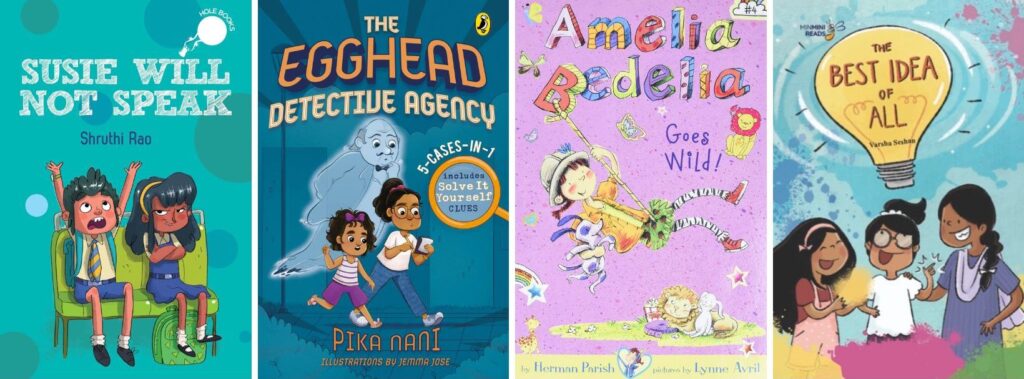
January 9, 2023
We love the Feather Tales series at my book club! I didn’t choose to read Talon the Falcon earlier because it is much shorter than The Golden Eagle and The Paradise Flycatcher, but when children fall in love with a series, how can we not read the whole lot together?
Set in the familiar Rose Garden, Talon the Falcon opens with a beloved character, Shikar, who wonders where all the birds have disappeared. He soon finds the reason – the presence of a falcon in the neighbouring garden! Of course, the birds, terrified, have flown away. But everything isn’t as it seems, and Shikar soon realises that the mighty falcon needs their help.
Here’s what we’ll do as we read Talon the Falcon together.
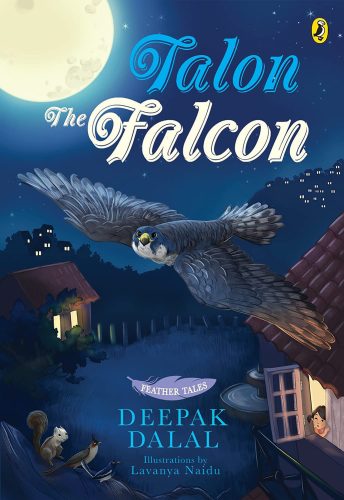
Birds of a feather flock together.
Bird-brained.
Chicken-hearted.
I never tire of working with theme-based idioms with children. A quiz always brings a surge of energy!
The stunning pictures in Talon the Falcon add magic to the story. More, illustrations like these are perfect to learn about birds around us. As a child, I knew nothing of bee-eaters, drongos and sunbirds. Books like this can change that! During one class, I will also ask the children to talk about a bird they love, and what makes that bird special.
The falcon and the other birds sing two beautiful songs, which will serve as the perfect introduction to list poetry. I love list poems, and I’ve lost track of the number of times I’ve worked with them. Here’s one that a child wrote at one of my first creative writing programmes. It’s time for more!
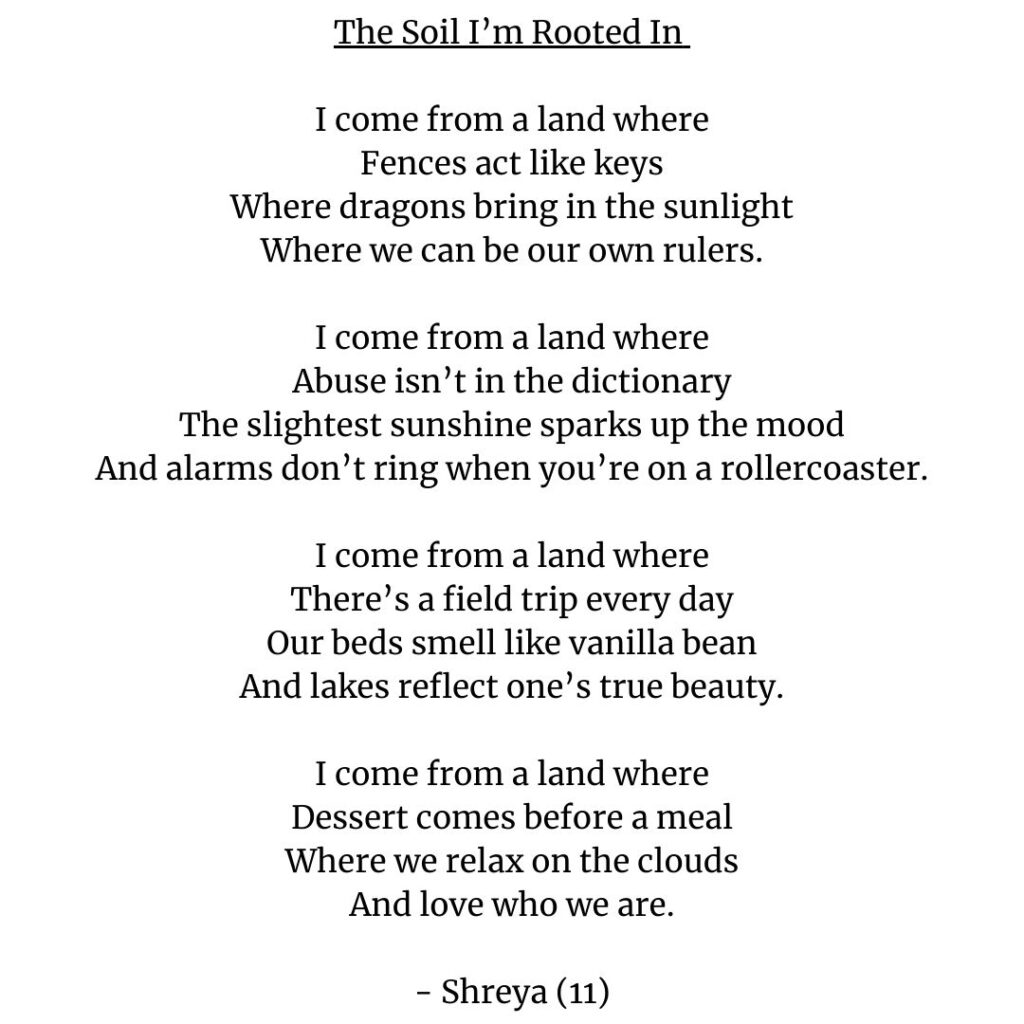
REGISTRATIONS ARE NOW CLOSED FOR THIS EDITION OF READ, WRITE, EXPLORE.
New batches begin every alternate month. If you would like to receive email notifications about my programmes, please fill this form. Alternatively, follow me on social media – Facebook, Instagram and Twitter – for regular updates.

January 6, 2023
The year 2022 was all about flexibility.
Conducting online sessions from cafés and hotel rooms.
Finishing an online session before boarding a bus to do an in-person session in another city.
Adjusting schedules.
Cancelling some editions of my book club because children were – finally – travelling.
Competing with swimming and cricket coaching and all the other things that weren’t factors I needed to consider at all in 2020-21.
And it’s been quite a journey. We did so much; I met so many people; I travelled extensively for work. I can’t help wondering what 2023 is going to be like!
I launched my first book club in December 2020, and look how far we’ve come! Yes, we read ALL these books in 2022. I read 14 with ages nine and ten, and 18 with ages seven and eight.
Yes, there were sessions I had to cancel. In 2022, children started going to school again, and their schedules slowly filled up. Yet, before I could wonder what I was doing wrong and why people weren’t signing up, parents would write and ask me for a different time-slot. They wrote and wrote and wrote again, reaffirming that they loved the book clubs, loved reading with me … but just couldn’t fit my book club into the children’s schedule.
And that’s what keeps me going. I did have to cancel three sessions across age-groups in 2022. But that hasn’t stopped me yet!
My writing programmes remain as rewarding as ever. With children signing up time and again, it’s wonderful to see them blossom and grow. Poetry, drama, nonfiction, fiction … we’ve explored it all. Just like in 2020-21, I invited experts from various fields to address the children, and these were a treat!


During each edition of my creative writing programme, there are so many pieces I love that in April 2022, I decided I would bring these pieces together in a zine of our very own. So, June 2022 saw the launch of the first issue of WORDS, written by children aged nine to 14! The second issue came out in January 2023, and I’m sharing that here too, since all these pieces were written in 2022.


And of course, with schools reopening, my offline workshops began again too. Teacher-training sessions took me to Nagpur, Mumbai, Aurangabad, Goa, and all over Pune. Lit fests took me to Gurgaon, Bengaluru, Vadodara and Jaipur–but more about those when I write about how 2022 was for me as a writer.
My 2023 calendar is already chalked out. My reading sessions continue, new batches are around the corner, I have sessions lined up in Mumbai and Goa … I’m waiting to see what the year brings!
November 12, 2022

What fun we had at ‘Building Dramatic Characters’ – a guest session conducted by Neha Singh for my creative writing programme!
To quote Neha, anything can be a character. Maybe even a chair talking to the moon! The strength of a character simply depends on how much you have invested in the character to make it full-fledged and believable.
Step by step, she led us through the process of creating dramatic characters of our own, and before we were even halfway through, here are the characters we met:
Each child chose three props and gave their character a unique voice. Neha asked the characters questions, and we explored how we could help each one reach its goal. Now, I wonder what stories the children will come up with based on the characters they created today!
November 7, 2022
With Flipped – Mystery Stories and Sci-Fi Stories, we have another first at my book club – an anthology! Full disclosure – I have a story in Flipped too, but we won’t be reading that one.
I love the idea of the Flipped books. You read a few stories, then decide you want another kind of story, so you just flip the book over and discover another genre. Short stories work well at my book club too, so there’s a lot we can do as we read this anthology.
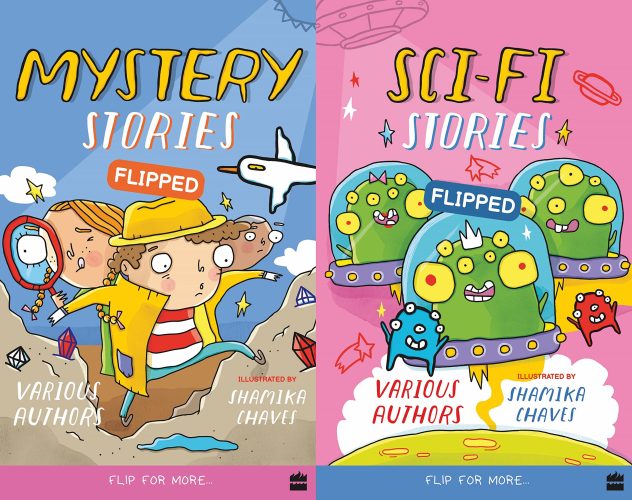
A couple of years ago, I invited a friend and NASA scientist, Dr Sreeja Nag, to conduct a session for my writing programme on science stories. Like every other guest session I’ve organised, I learned a lot from the session. What is science fiction anyway? What kinds of stories make for believable science fiction? Taking an idea from another session Sreeja conducted, we’ll explore a few writing prompts. Set a story in a place without gravity! Imagine an alien visits the earth. Create your own spaceship. What else?
I’ve said this before, and I’ll say it again – I love codes! We’ll play with a few simple codes and then write coded notes to each other in the chat box. Perhaps we could even invent a code of our own!
Mystery stories are fun to read and fun to write. We worked extensively with mystery stories at my writing programme in April, and two stories the children created feature in issue 1 of our zine, Words. We’ll take small steps in the same direction as we read mystery stories at Read, Write, Explore in December ’22 – January ’23
REGISTRATIONS ARE NOW CLOSED FOR THIS EDITION OF READ, WRITE, EXPLORE.
New batches begin every alternate month. If you would like to receive email notifications about my programmes, please fill this form. Alternatively, follow me on social media – Facebook, Instagram and Twitter – for regular updates.

November 5, 2022
I read Crenshaw over two years ago. In fact, it was one of my top reads of 2020, and it’s a story that has stayed with me since then, a story I think about often because of its portrayal of friendship, loneliness and vulnerability.
Crenshaw is the story of a boy, Jackson, and a giant cat. What role can a giant cat have in the life of a boy who loves facts? How can Jackson reconcile his need for truth with the … fact … that he has an imaginary friend? I’m waiting to share this beautiful story with my book club!

Do you have an imaginary friend? Have you ever had an imaginary friend? Children make up all kinds of companions; after all, that’s what dolls and toys are for. I’d love to know what characteristics they give either temporary or more permanent imaginary creatures in their lives.
As always, the advantage of reading a popular book that is often used in schools and book clubs is the wealth of activities I can find online. We’ll play word games and discuss the keepsakes Jackson and Robin treasure – the books A Hole is to Dig and The House on East 88th Street. If time permits, we’ll read excerpts from these two books too and talk about why the children in the story treasure them.
What I love most about Katherine Applegate’s writing is her simple, poetic style. It makes each emotion come alive, hitting all the right spots. Can we write poetry like this? During the creative writing class for Crenshaw, we will try to write a list poem in free verse about someone in our lives whom we treasure.
REGISTRATIONS ARE NOW CLOSED FOR THIS EDITION OF READ, WRITE, EXPLORE.
New batches begin every alternate month. If you would like to receive email notifications about my programmes, please fill this form. Alternatively, follow me on social media – Facebook, Instagram and Twitter – for regular updates.

November 4, 2022
It’s time to introduce another series to my book club – the Gulgul series! I wonder if the book is targeted at slightly younger readers than my book clubbers, but the number of things we can do with Gulgul in Jungalu prompted me to select it.
Gulgul is mischievous, resourceful and friendly, the perfect protagonist of an adventure story. She must befriend not just elephant-like creatures, but also flippots, bluglugs and longfellows in order to help her mother Megha build a zingjuck that will shoot them into space where they will have phone coverage to call a spacecab!
Full of wacky words and even wackier animals, Gulgul in Jungalu promises to keep my book clubbers giggling as we read.

Imagine you’re travelling through space. What planet are you from? How do you travel? How old do you have to be to drive a space vehicle? What are your favourite picnic spots? The list of questions we can work with is endless! Let’s see what we can create together.
The cover of Gulgul in Jungalu reveals what looks like a hippo that can fly and an elephant with a very long trunk. We’ll let our imaginations go wild as one child describes the animal of their imagination and the others draw what they can based on the description. We’ll come up with new animals that no one has dreamed of!
What if an alien landed in your balcony? What would you show them? What would you want them to eat, see, smell or experience? If time permits, we’ll write a short piece about an encounter with an alien.

October 30, 2022
One of the best things about my creative writing programmes is how much I learn on the way. For one, before each class, I research for hours. One hour of class time typically requires at least four hours of research.
And for another, I invite guests to talk about a variety of subjects from science fiction to cyber crime, historical fiction to comics.
Our latest guest was Andaleeb Wajid, a hybrid author who has published 37 novels in the last twelve years! Since so many parents and children have questions about Kindle Direct Publishing and whether they should publish their children’s work at all, Andaleeb was the ideal guest. Step by step, she took us through the process of publishing, comparing traditional publishing with KDP, with complete frankness when it came to costs, timelines and control.

For the most part, we followed a Q and A pattern for the session. Here are two answers that stood out to me.
What do you think about self-publishing, especially when it comes to children?
Free publishing platforms are now available to us, so go ahead and publish! Remember, though, that you should publish the best version possible. Work on your writing, edit, and get feedback. Because your name is going to be associated with that book.
Do you have advice when it comes to publishing children’s work?
Whether adults or children are looking to publish, my question is the same: why do you want to be published? Do you want to make money? Become famous? Or do you just want to get your work out there?
If you want to make money, publishing via KDP could work. If your book is well written and you market it well, you will find readers and make money.
If you’re looking to publish because you want to become famous, KDP is not the route I recommend. Your book isn’t going to be at a store. In India, KDP is restricted to ebooks, plus distribution networks don’t really make space for self-published books.
If you want to publish your book because you have spent so much time and effort writing it that you just want it out there, go for it! Publish. It gives you a sense of achievement!
The session was informative and useful; I can’t wait for the next one!
September 13, 2022
Just like the second book we’re reading this time, Yikes! Bikes!, The Adventures of Mooli and the Bully on Wheels features characters some of my book clubbers have read about before. In December 2021, we read the third book in the series, The Adventures of Mooli and the Sticker Trickster. It’s time to meet Mooli again!
Mooli and his friend Soups are fun, enterprising characters, itching to try something new. After all, they want to win a prize on WAYOUTS – World’s As Yet Original Untried Tricks and Stunts. Toothpaste art sounds like a good idea–or not.
Funny, silly and full of wacky ideas, Mooli is a character with whom book clubs are fun!
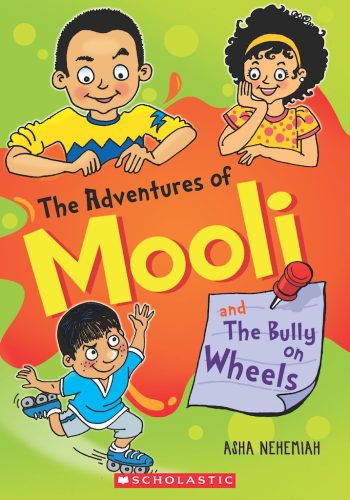
Mooli tries to create art using a tube of toothpaste. We’re not going to waste toothpaste, but we are going to have fun with art! Can the children draw with their eyes closed? Or with their non-dominant hand? Or without lifting their pencil from the paper? Let’s find out!
We discussed this during my December book club, and we’re going to discuss it again. What unusual and untried ideas can my book clubbers come up with for a fictitious WAYOUTS entry? What can they do that has never been done before?
This time, we’ll take our WAYOUTS ideas one step further, working with a little writing too. I’d like the children to imagine that they’ve created something they would like to send for the WAYOUTS competition. We’ll work on a cover letter that they could write to accompany their entry. Letter-writing is always enjoyable!
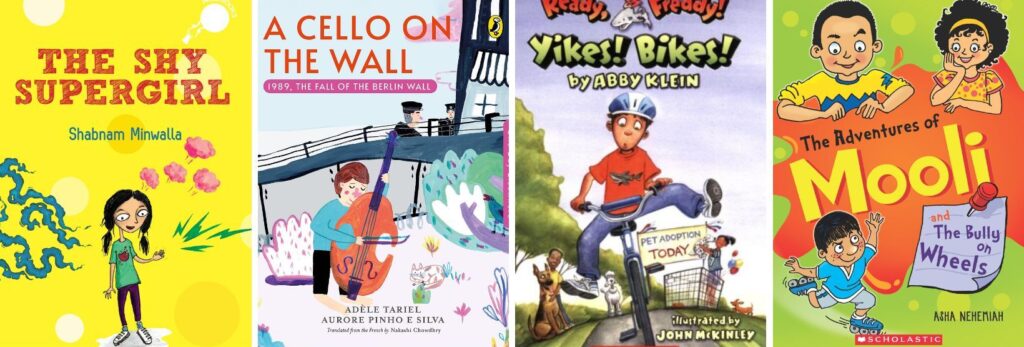
September 9, 2022
For the first time ever, we’re going to read one of my books at my book club! I am in equal parts nervous and excited.
Yes, Dragonflies, Jigsaws and Seashells was shortlisted for the Scholastic Asian Book Award.
Yes, it’s been published both by Scholastic Asia and Scholastic India.
Yes, it was shortlisted for the Singapore Book Award.
That doesn’t make me any less nervous!
I chose this book of mine because reading Dungeon Tales II convinced me that short stories are perfect for Read, Write, Explore. We will read excerpts from three stories in class and do activities based on the stories, concluding the edition by writing something of our own.
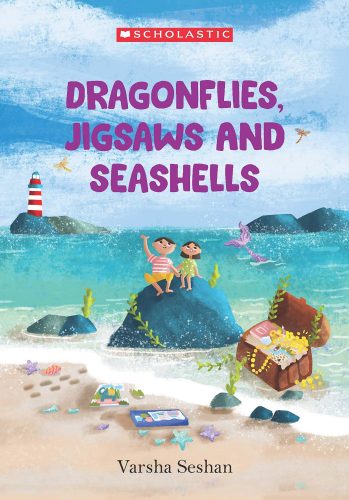
A book club is all about having fun, so we’ll begin with an online jigsaw puzzle. I wrote the story “Jigsaw Puzzles” because I loved jigsaws as a child. Like Aniket in the story, I would make regularly a mat of jigsaw puzzle. (Also like Aniket, I won a jigsaw puzzle competition, but that’s another story.) At each author event I did for Scholastic, I shared a puzzle for the children to solve, and I can’t wait to do it again!
I remember how much fun I had playing a jaltarang, and that will bring us to another activity – one where the children fill water in glasses and tap on the glasses to listen to the sound. Using glass will require parental supervision, so we may work with steel or plastic instead, which isn’t as rewarding, but is fun, nonetheless.
The story “A Drawing Lesson” is all about sharing. Can two children create art together? We’ll brainstorm ideas and then attempt to create a rhyming poem (or several!), not on our own, but with a partner or two.
Sharing stories I’ve written with children who’ve been reading with me for two years is all kinds of special. This edition of Read, Write, Explore sure is going to be fun!
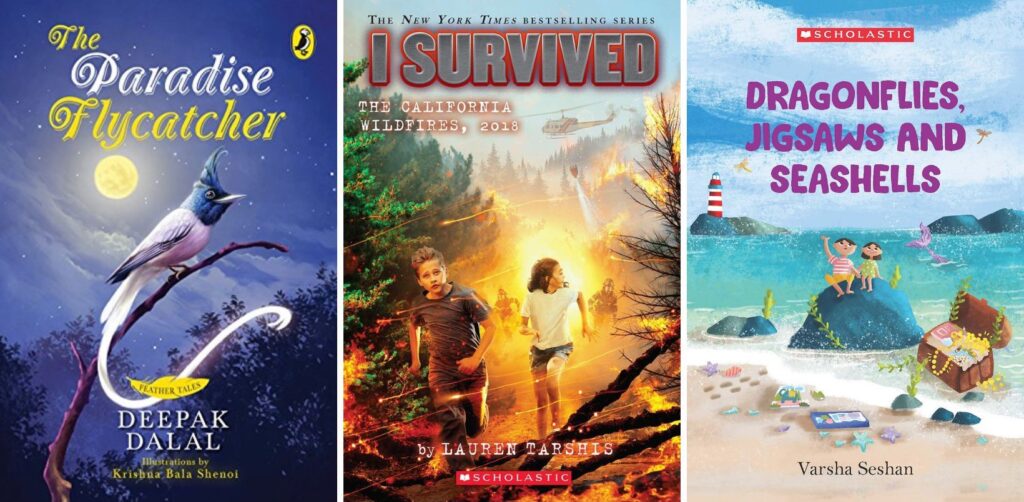
September 5, 2022
We had so much fun with The Reading Race a few months ago that I was sure I wanted to do another book from the Ready, Freddy! series sooner or later. Yikes! Bikes! is perfect.
The animal shelter in Freddy’s town has organised a fundraiser, one that involves a Bike-a-thon. Max Sellars goads Freddy into making a bet with him, and the young protagonist rashly bets that he can ride more laps than the class bully.
The problem? Freddy can’t ride without training wheels yet and he has just two weeks to figure it out!
Lighthearted and humorous, Yikes! Bikes!, like The Reading Race, allows us to do a lot as we read it together at my book club.
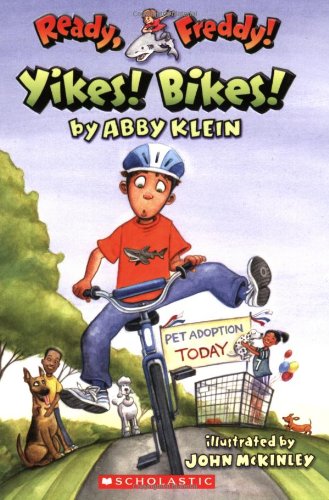
As we read The Reading Race, everyone took part in a different sort of race – seeing who could find the word “fin” hidden in the pictures first! The protagonist Freddy loves sharks, so the word is hidden in each picture of Yikes! Bikes! too. Plus, there are puzzles at the end, which I’m sure we’ll enjoy solving at my book club!
Riding a cycle can be challenging, and this is the perfect stimulus for a conversation about things we do that seem difficult or frightening at first. What did you decide to do even though you were afraid? Sometimes, it is equally brave to refuse to do something that all your friends are doing. I’d love to know if the children have experienced that too!
The Bike-a-thon in Yikes! Bikes! is in aid of the animal shelter, and Freddy is enthusiastic about participating even though he knows his mother will never allow him to have a pet. Children and animals share a very special bond, and this will be the perfect occasion to talk about unusual pets, as well as pets the children may already have. I used to have a virtual pet too – a panda! I wonder if that’s more common now – I’m waiting to find out.

September 4, 2022
During my first two writing programmes in 2020-21, one participant (who wrote this poem) recommended the I Survived series. She spoke about it time and again, and somehow, I never ended up picking up a copy. In June this year, when I travelled to Nagpur for a set of workshops, I ran out of books to read, so I visited Crossword. There, I came across the I Survived series and decided it was high time I read at least one of the books. It’s perfect for my reading programme, Read, Write, Explore!
The I Survived series tells the stories of young people caught in disasters and turmoil out of their control. I wanted a book that is set in the lifetime of my participants, which is why I chose I Survived the California Wildfires, 2018.
Many of us read about the deadliest fire season in a hundred years, and the story of a pair of cousins escaping a forest fire is a compelling one, perfect for a book discussion. The protagonist Josh is in the midst of a personal crisis too, providing us with the perfect opportunity to discuss characters, problems and setting. Ideal for a reading programme that introduces creative writing!

All of us know about the climate crisis. Even as I write this, Pakistan is experiencing the worst floods in a century. What should we do? Can we do anything? I will ask each of the children to share something they know about climate change and climate activism; I’m sure all of us will learn something new!
What kinds of words build suspense and tension? How do cliffhangers at the end of each chapter work?
Vocabulary games are always fun, and we’ll see what words we can use to create greater emotional impact. We’ll also work with a few literary devices – the book is full of examples of personification and hyperbole.
Josh is nowhere near perfect. Does a protagonist need to be perfect? Let’s explore this!
The blurb of I Survived the California Wildfires 2018 says that a family crisis is ‘burning him up inside’, even as a wildfire blazes around him. And here, we have something else to discuss – the way character’s story is intertwined with the larger setting.
And finally, as we discuss this, we will look at different kinds of conflict – internal and external – and how writers use both in multiple ways.

September 3, 2022
War is a difficult subject to introduce to children, and I’m often unsure of whether it should be introduced at all. Yet, most children are exposed to so much media and are aware of so much that is happening around them that I think stories of hope are important.
Yes, history is full of war. But in the darkest of times, love and kindness do triumph.
A Cello on the Wall is part of the One Day Elsewhere series I read nearly a year ago. The series explores important events in history through the eyes of a child, and A Cello on the Wall is about the fall of the Berlin Wall. Young Charlie – named after Checkpoint Charlie – cannot imagine a time when the wall did not exist. But he is part of the momentous fall of the wall, the day when east and west Berlin come together again.
At my book club, as we read Charlie’s story, here’s what we will explore.
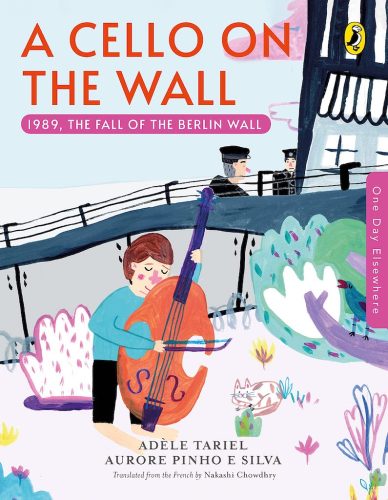
When we read The Absolutely True Adventures of Daydreamer Dev, we explored the world through the story as well as through Google Earth. I was amazed at how well it worked – showing children the earth and helping them find different places on the map. To understand where Berlin is, and to place it in its larger geographical context, we’ll explore the world through Google Earth.
A Cello on the Wall is a book that we’ll begin reading from the back. One of the joys of the One Day Elsewhere series is the simplicity with which facts are presented at the back of the book. I often struggle to decide how much context to give children when it comes to books about war. With The Butterfly Lion, we explored quite a bit because the children were older too. With A Cello on the Wall, we’ll start with a little history and then come to the story itself.
A Cello on the Wall is a work of fiction – the story of a boy who discovers the joy of music. I love exploring music and literature together, and I’ve done it so many times – most recently with Malhar in the Middle. A book like this is perfect for us to explore links with the world outside literature. What music do the children enjoy? If they’re willing, I’d love for them to share a song or play a tune for us!

September 1, 2022
When I launched my book club in December 2020, I began with a hOle book, Trouble with Magic by Asha Nehemiah, and somehow, that became a tradition. During each edition of my book club, the first book we read is a hOle book. This time, it’s Shabnam Minwalla’s The Shy Supergirl.
The Shy Supergirl is such a lovely, lovely book! It captured my heart from the very first paragraph. Nina Merchant is a supergirl. She isn’t strange; she’s special.
What’s her superpower? That she can look at a person and tell what kind of person they actually are – nice or nasty, evil or kind. That’s why she shrieks when she sees her father’s boss, but loves the schoolbus driver, Singhji, who seems to be rather scary looking.
This superpower comes in handy when there’s a theft at Venus Towers! Who stole Mrs Khanna’s priceless silver owl? Was it Nina’s best friend Buggy’s cunning cousins? Or Mrs Khanna’s nephew Robin? Nina must find out!
Here’s what we’ll do as we read The Shy Supergirl at my book club.

Two years ago, when we read Shrinking Vanita, we explored superpowers and superheroes. There’s so much more we can do, plus my regulars have all moved from the book club for older children. I’ll introduce the structure of a story in terms of a problem and a solution, and we’ll explore superpowers and create superheroes together.
I find the link between colours and emotions fascinating. Nina sees colours around people, and that’s how she can tell what kind of people they are. Pink puffs of happiness, green sparks of sneakiness, splotchy orange clouds of lies … what else? What colours do we associate with various moods?
I love clues, riddles and treasure hunts! The Shy Supergirl features a treasure hunt in which the children have to solve riddles that are written in the form of rhyming couplets. I’ve worked on rhyming puzzles several times in the past (you can find some in our e-zine, Words!). We’ll try to solve a few of our own too!

July 6, 2022
Yes, Help, My Aai Wants to Eat Me! is as mad and fun as it sounds. I know LOTS of people who express affection by saying they want to eat people up. People like Avi’s Aai who thinks Avi is so adorable that she wants to eat him.
The problem is that Avi thinks she’s for real. And when his Aai is ill, he’s sure that he is being fattened up for her, rather like the story of Hansel and Gretel, where the witch fattens children up to eat them …
It’s humorously horrifying, but also sweet and charming; we’re definitely going to enjoy reading Help, My Aai Wants to Eat Me! at my book club.

Avi looks at the pros and cons of everything, and we’re going to use this idea in class. What are the pros and cons of reading in a group? What about of online book clubs? Schools reopening?
Each day that his mother is sick, Avi writes a little note, just like his Aai would do. The notes are no more than a few sentences long, the perfect way to take our journalling journeys forward! We’ll take ten days to read Help, My Aai Wants to Eat Me! at my book club, and during these ten days, I’ll ask the children to write a little note to themselves every day. At our last class, we’ll share the most interesting ones with the others.
A cup of tea. A piece of cake. You’re toast. A lemon (we came across this when we read Amelia Bedelia Means Business too!). What else? We’re going to be reading yet another book about food, so we’ll take our food explorations one step further by exploring the ways in which food finds its way into the English language.

July 4, 2022
Every so often, at my book club, I choose a popular, internationally loved book. We’ve read The Rise of the Earth Dragon, The Absent Author, The Sheep-Pig … and now, we’ll read Ivy + Bean.
The enemies to friends trope is always fun. Ivy and Bean never meant to like each other. In fact, Bean is quite sure she has enough friends. She doesn’t need another one, especially not someone who seems as nice as Ivy. She knows only too well that nice = boring. But when Bean decides to play a trick on her sister, she realises that Ivy is not as nice as she seems. And that’s a good thing.
Funny, silly and full of action, Ivy and Bean is perfect to read with a bunch of seven- and eight-year-olds!
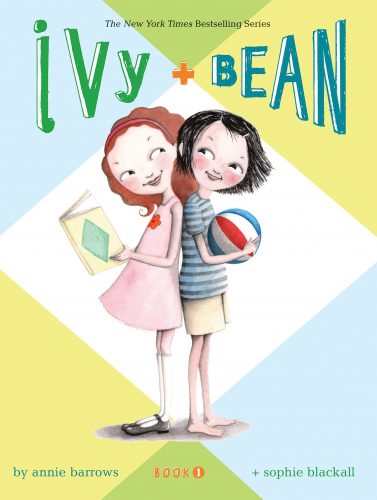
Before we start reading the book, I’ll show the children a video trailer and ask them to imagine what the story is about. I know that some of the children will have read the book already, so I’ll take this activity further with a story worksheet. I’ll tell them the beginning of a story and then, based on the pictures I show them, I’ll ask them to make up the rest.
Ivy wants to be a witch. She has her wand, her spell-book, everything. It’s the perfect prompt for us to invent some magic of our own! I love asking children to imagine that things around them are magical. What if their pencil was magical? Or their chair? What magic can they do?
If we have the time, we’ll also try to do some craft work where we make magical wands of our own.
One of the fun things about introducing a popular book to my book club is the number of resources I can find online. From quizzes to worksheets, discussion questions and crossword puzzles, there’s a range of stuff that people have created and shared. Waiting to use some of them at my book club!

July 3, 2022
I read Frindle quite a long time ago, and it’s EXACTLY my kind of book. I didn’t end up reviewing it on my blog because I kept waiting for a time when I felt I could read it with my book club. I almost selected it once, but one of my regular book clubbers was reading it at school, so we read About Average instead. Now that he’s too old to be part of this book club, I quickly picked it up again!
Nick Allen isn’t really a troublemaker. He just likes to have fun. And where’s the harm in making up a new word?
Pen. Quite a boring, mundane word. Why not call it a frindle instead?
And that’s the premise of this delightful, fun story that keeps you reading page after page. I love how the book is plotted as well as how the characters develop as the story proceeds. Finally, a book about words is perfect for a book club!
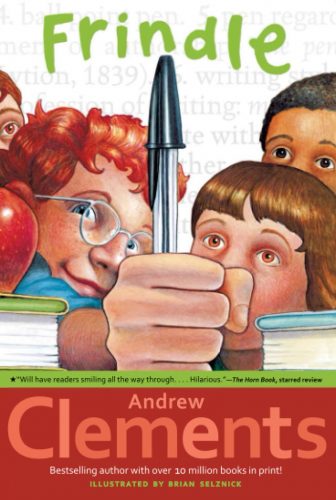
As so many children have just come back after their summer holidays, chapter three is perfect! Following Nick Allen’s school system, we’ll talk about our summer, do a quick vocabulary quiz, and then come to the most fun thing of all – the time-wasting question. I know that this part will make the children giggle, and I can’t wait to see what mischievous, fun ideas they come up with when we discuss what they do to postpone a lesson just a little bit!
When we read Paati Goes Viral, we spoke about how words are created, and how their meaning changes. We then made up words of our own, which we promised to use right through that edition of my reading programme. I remember at least three words the children created – sclem (which was to substitute ma’am), electric (to use instead of viral) and trook (for book). It was such fun!
With Frindle, I look forward to doing something similar. We’ll create new words and see how successful we are in making them common parlance.
No spoilers here, but Mrs. Granger writes a letter to Nick and sends it to him ten years later. He knows it’s the same letter because he wrote his name on the envelope. The letter itself turns out to be the most brilliant surprise ever.
We’re going to work with this idea in two phases. Phase 1 is where the children will make a little time capsule for themselves. Time capsules get lost, though. So, I’m also going to ask them to write notes to one another, which they will send to me privately in the chat box. Ten years later, if I can get in touch with them again, I will send them their letters. They’ll be adults by then!
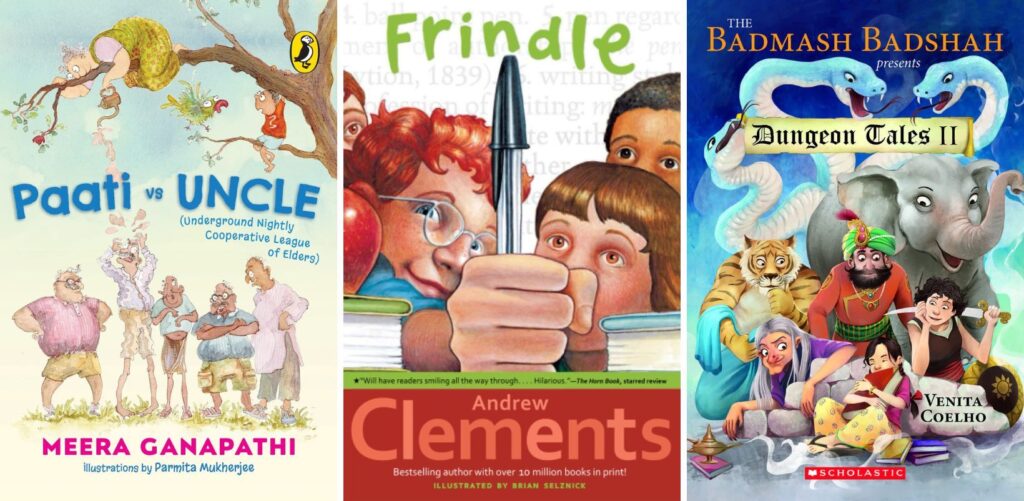
July 2, 2022
The Great River Magic by Nandini Nayar is one of those books with a message, not usually an obvious choice for me to read at my book club. Yet, as I read this book, I was charmed by the premise. I love stories about families, family traditions, and the ways in which people follow or break them. The Great River Magic touches upon all this!
Sangeeta – whom her grandmother insists on calling Gita – is the firstborn child. In the village of Rajpur, this means that she must take over the family business. What if she doesn’t want to? That’s just one part of the mess that Rajpur is in. Rajpur is famous for its wonderful, top-quality products of all kinds, but of late, people have been complaining about odd smells and inferior production. Sangeeta and her siblings must use their skills to investigate. Together, they find the courage to stand up to the adults and set things right.
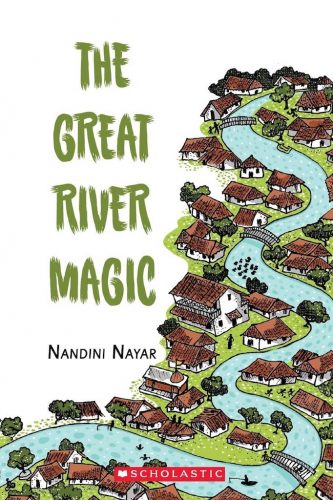
The very idea of a magical river makes me light up! We’ll do a quick written activity with this book, creating magical rivers of our own. What makes the river magical? Is there anything that can destroy the magic of the river? How can we restore its magic?
Every child today is aware of pollution, climate change and the ways in which we are destroying the environment. What can the children do to save the world? And more, what would they like adults to do? Conversations with children are always interesting, and I’m waiting to see what the children say during our discussion!
When we read Malhar in the Middle, we spoke about traditions we love and traditions we would like to change. One child said that she would like to wear a cap and trousers for Diwali; others spoke about things that only girls do during festivals.
I’d love to take the conversation forward with The Great River Magic. The village of Rajpur has traditions that the children in the story rebel against – the perfect backdrop for our discussion. Beginning with traditions we love, we will also talk about traditions we don’t like and that we would like to change.

June 30, 2022
We’ve read Bookasura and Koobandhee; we’re all set for yet another book by Arundhati Venkatesh – Petu Pumpkin: Tiffin Thief.
Petu Pumpkin. Isn’t it a fun name? And doesn’t it seem apt that he would be a tiffin thief?
The question is: what can his friends do about the fact that Pushkin aka Petu Pumpkin eats everyone’s food?
They must come up with a plan.
And of course, the plan must be secret.
And a secret plan requires a secret society.
And a secret society must have a name, a leader, a secret meeting place and a password.
Petu Pumpkin: Tiffin Thief is a fun book that I’m sure we’ll enjoy at my book club. Here’s what we’ll do with it.

Growing up on Secret Seven and Famous Five, I don’t know how many clubs my friends and I set up. The one I remember most clearly was a club called Helpful House, whose mission was to save the world. We made badges, had meetings, and even had a secret signal to get one another’s attention.
Petu Pumpkin: Tiffin Thief is the ideal book to inspire us to set up a secret society, and who will the members be? The children at my book club, of course! We’ll come up with names and a password, and we’ll try to make badges too. We already have our meeting place!
I love codes! They’re great for secret and not-so-secret messages. We’ll explore the code the children in the book work with and then create one of our own. I’ll also give the children a code to solve. I know it’ll be fun!
A book about food requires conversations about food. What is your favourite food? Now that the children are back at school, I want to know what they love eating and what they hate eating, which will lead us to the question of what they think they will never eat – like spinach that smells like the dirty nala!
Maybe we’ll also have an eating meeting, where all of us bring something to eat and talk about it as we read and eat.

June 14, 2022
The last guest session at this edition of my creative writing programme was with Daphne Lee, consulting editor at Scholastic Asia. It was everything I expected it to be – informative, detailed, and full of laughter. She answered questions, told us about the publishing process, and shared a manuscript with us, detailing how the editing process works. It was fascinating to see how the book took shape!
Here are a few of the questions I asked and the responses we received.

Varsha:
How do you decide whether to publish a book?
Daphne:
It’s hard to say. Voice is key. Things like grammar and spelling mistakes matter less. To me, even plot does not matter as much as voice. Thoughts and ideas draw me in.
Varsha:
While I understand that typos and grammar may not be the only things that are crucial, what do you feel about shoddily edited work? Work that seems carelessly written?
Daphne:
I think it really depends on the story and whether I’m willing to put in the work that publishing it would involve. The grammar won’t make my decision for me; the story and the potential I see in the voice do.
I also don’t like writing for an author. I make suggestions, but I don’t want to do the writing for them. More than once, I’ve cancelled a contract because a book isn’t shaping up the way I would like it too. But I suppose that is part of the job!
Varsha:
How many manuscripts do you typically receive per week?
Daphne:
Between 20 and 50 unsolicited manuscripts, I would say. I mark them as submissions and I allot some time to read them, but it’s time-consuming. The Scholastic website does mention how long to wait before considering it a pass from me.
Varsha:
Do you ever publish work written by children?
Daphne:
No, that’s also the company policy. You have to be 18 to submit work, and I agree with it. Where’s the rush? I know that when I was a child, I found myself imitating the style of the book I last read, and that is natural! I think you need to give yourself the time to find your own voice.
Varsha:
What about self-publishing? What do you feel about that?
Daphne:
Just my opinion, but like I said, children haven’t yet found their best voices. Yes, they are writing the best they can, but self-published work is often unedited. It isn’t even proofread. Do you think it’s fair to charge people to buy a book that is sub-par? Writing doesn’t pay anyway, so I think that publishing is just the icing on the cake, to use a cliche. If you enjoy the process of writing, don’t obsess over publishing your work.
Daphne also spoke about writing our own stories – stories about people and places that represent who we are. I was so glad she did!
All in all, it was quite an intense session, one that I wish I could have attended when I was a child!
June 7, 2022
Day three at AFCC 2022 was the whole reason I was there. Book launch day! Of course, that was the highlight of my day, so even though that did not technically come first, I’m going to begin with it.

My book, Red Eyes, has been a long time in the making. I’ll write about the story behind the story (like I did for Dragonflies, Jigsaws and Seashells, The Clockwala’s Clues and Sisters at New Dawn) soon, but launching it at the Asian Festival of Children’s Content was such a delight! Equally delightful was listening to the other three authors talk about their books. I would love to read them all!
The book launch was a public event, so you can still watch it here.
Now, I’ll come back to everything I attended as a participant, and all that I took away from the festival.

A few weeks ago, I organised a comic-making workshop for the children at my creative writing programme, and I was amazed that every single one of them managed to make a four-panel comic strip in an hour. Honestly, that was the main reason I attended this session on comic-making. The power of comics is huge! And teaching comics can be quite rewarding too.
We use comics in one form or another all the time. For instance, how many comics have you seen over the last couple of years telling you to wash your hands? For reluctant readers, comics are far more approachable, and even for adults, infographics often work better than dense text.
One important idea I took away from the session is the fact that if you’re not seeking to be a comic artist, i.e. if you are using comics as a trigger to express yourself, you really don’t need to draw at all! Take pictures of yourself and paste them, creating a comic of your own!

I attended the presentation on diversity and inclusion synchronously, and I thoroughly enjoyed it. Among other things, Radhika Menon spoke about exposing children to diverse stories to make them aware that languages other than the ones they speak exist. Adivasi stories are important and are finally being translated and published. The inclusion of languages that children may not understand helps build awareness that there exist other realities.
Just like in so many other sessions I attended at the AFCC, Reni Roxas spoke about how much talking pictures do in picture books. In the context of inclusion, I loved the image she shared of the book Seven Slippers. Along with three pairs of slippers, there’s one singleton. And then, within the pages of the book, we see that the single slipper is accompanied by a crutch. All the text says is Lonely slipper, come join us!

This was one of the most enjoyable sessions of AFCC 2022! Of course, it is unsurprising that so many people have studied humour, but I was amazed at the number of theories as to how humour is created – the superiority theory, cautionary tales, the incongruity theory, irony, the concept of the carnival, benign violation … And the speakers explained each of these ideas with examples. It was eye-opening!
Although I did attend other sessions on day three, I didn’t find them as engaging. I also know that the magic of a lit fest fades as days go by, so I’m not as enthusiastic about watching recorded sessions as I am about attending them live. I didn’t attend much on day four, so that’s all: AFCC 2022 was a two-week long lit fest for me!
June 3, 2022
Day two at the Asian Festival of Children’s Content was on 27 May, but I caught up with all the sessions I wanted to just yesterday. I felt like I had a time-turner because I attended three simultaneous sessions, thanks to a virtual AFCC 2022! Here’s an overview of how the day was for me.

This was one of the sessions I attended synchronously, and the experience of doing that is quite different from catching up with an event later.
The environmental is a subject close to my heart, and I read a lot of literature about nature and being outdoors. However, I’m a little iffy when it comes to books that are clearly issue-based, no matter what the issue may be. Story, for me, comes first, and advocacy second, not the other way around. I like it when books are subtle, with characters nudging us in particular directions. And that was one of the reasons I wanted to attend this session!
And it was a rewarding one. A great takeaway was the list of books Sarah Ang shared to promote eco-consciousness amongst children. In addition to books, however, she spoke of activities we can do, emphasising that books are important, but even more important is being outdoors. Environmental advocacy can begin in a book, but must go further!

Much of Dimity Powell’s session worked with ideas that are not new, and I think I enjoyed listening to it for exactly that reason. Had I been younger, I would probably have found a lot to take home from the session – including the idea of balancing the story you want to tell with marketability, something a younger me would have been quite disillusioned by!
The discussion about the interpretative nature of books made me think of both my book clubs and the books I’ve written. When we read When the World Went Dark, for instance, the children were convinced that Pitter Paati was not dead – and this is something that Powell spoke of too, in the context of another book. Children do not necessarily make links that adults make very easily. However, this makes a book more relatable, rather than less understood.
The discussion on illustration was enriching too! Once upon a time, I used to think that writers and illustrators work closely together. Now, having written four picture books and two chapter books, I know that an author may not even know who the illustrator is until the final pdfs are ready! And this is a good thing because, as the moderator David Liew said, the book then tells not one, but two stories. One story is told through the words and the other through the pictures. One of my favourite examples of that is The Monster Hunters, which we read at my book club!

What a beautiful session this one was! I wish I could have attended it synchronously because I would have loved to “talk” to Margarita Engle in the chat box. Especially as I’ve been writing a lot of verse recently, much of what she said resonated with me.
While teaching a poetry module recently, I began to do some research on how to introduce children to free verse. I came across the idea that breaking sentences up into smaller lines creates poetry.
I was uncomfortable with this.
No.
This does not create free verse, or so I feel.
That’s why it was especially heartwarming to hear Margarita Engle put this into words! You have to be in love with poetry to write poems, she said. Inserting random line breaks into prose does not create poems.
Yes!
And yet, poetry can be whatever you want it to be. Engle spoke of the white spaces in poetry being open spaces where the reader can meet the writer, where emotions and thoughts can interact. Verse novels, she said (and I agree), are so full of open space that a young reader who may not always enjoy reading is not intimidated by dense text. It’s approachable, easy, accessible – diametrically opposed to the idea that poetry is somehow erudite and incomprehensible. And again, I found myself saying, yes, yes, yes!

The moment I saw that there was a session on developing critical reading skills at the AFCC, I knew I wanted to attend it. And guess what? Already, less than a week after the event, I’ve used some of what I picked up from the session.
Often, I conduct workshops for teachers on Bloom’s taxonomy and the importance of critical thinking. The more I engage with critical thinking in its many forms, listening to new perspectives and reaffirming older ones, the more I have to share in the form of training. Debra Ann Francisco’s clear list of challenges we face while attempting to develop critical reading was useful!
What is critical reading? This is the question we began with. Mary George drew a lovely analogy, comparing reading with SCUBA diving, and critical reading with deep sea diving. What I particularly liked about the comparison is that reading is a kind of diving too; it isn’t skimming the surface!
I also found it interesting to think about the importance of listicles in providing information in a capsule while also understanding that listicles take a toll on reading stamina. It’s easy to think that we know a lot because we’re exposed to a variety of subjects thanks to social media. But how much do we know? Have we considered that there might be other perspectives? Developing the ability to formulate these questions and answer them is really what critical thinking is all about.

What a sweet, fun session this one was! I do not work much with very young children, so I wondered how useful I would find a session on picture books. Even post-session, I don’t know about its usefulness, but I am glad I attended it because of the step-by-step approach the speakers took.
Inclusion is a three-step process – awareness, acceptance and appreciation. How do books help with that? When we read picture books with children, we help them notice difference, building awareness. With leading questions, we move towards acceptance. And finally, by taking the story beyond the book and into the world around us, we begin to appreciate difference.
Moving forward with this methodical approach, Soh Aiwen and Stephanie Ng spoke of three reading strategies to promote inclusion. When we read, we begin with literal questions before moving on to inferential and evaluative questions. Using clear examples of both texts and questions, the speakers went on to explore hands-on activities linked to the book too, which I loved!
That was day two for me – I’m still catching up with the sessions that happened on day three!
May 31, 2022

We just had another rewarding guest session! Niloufer Wadia, an illustrator and Urban Sketcher, covered so much ground in one short hour with my creative writing programme – you can guess what I mean from the picture above! From showing us different kinds of zines to telling us about storyboarding, she led us through the process of illustrating our works, choosing what to draw and helping us understand how to draw it.
The zines Niloufer showed us to begin with were lovely. Even though we’re going to be creating an e-zine at my writing programme, exploring form and shape was fun! Moving towards helping us sketch on our own, she shared some limericks with us and then proceeded to show us how we could illustrate them. She began with a storyboard with very basic line drawings, and together, we came up with ideas of how to illustrate the set of limericks she chose.
I also love it when guest speakers mention the importance of copyright. Even as we began to read the limericks, Niloufer paused to tell us about copyright, reminding us that even if we cannot find the name of the creator online, stuff on the internet is not ours to use as we wish!
Though there were a lot of takeaways from today’s session, if I had to choose one point I’d like to share, it would be the last bit of advice Niloufer shared with us. When you have an idea, don’t draw immediately. Think about how you can make it more – more ridiculous, warmer, more dramatic. And then, begin to draw.
It’s great advice!
May 31, 2022
It’s been four years since I attended the Asian Festival of Children’s Content.
2016 – my collection of short stories (now published as Dragonflies, Jigsaws and Seashells) was shortlisted for the Scholastic Asian Book Award, so I attended for the first time.
2017 – I submitted a paper titled Writing About Us, which was selected as part of a panel, so off I went for the second time.
2018 – my middle grade book (now published as Red Eyes) was the first runner-up for the Scholastic Asian Book Award, and yes, I attended the AFCC again.
I didn’t go in 2019 and then, with the pandemic, 2020 and 2021 were out of the question too. This year, Scholastic Asia sponsored a virtual ticket for me, so of course, I’ve been making the most of it. Attending virtually isn’t nearly as exciting as being there in person, but it does have one big advantage – I go back and attend sessions I missed because they’re available for viewing on the AFCC website for 30 days longer!

Yes, this was 6:30 am for me, but the keynote address was well worth attending! I took away so much from the session – both from what the speakers said and how they spoke. Neil Humphreys is a humorous, fun storyteller, and I thoroughly enjoyed how he talked about what inspired him to write his stories. But most of all, what resonated with me was his answer to the question on how to be a writer.
His answer?
Write.
And I couldn’t agree more. There are no shortcuts. If you want to ride a bike, you get on a bike and practise, practise, practise. And if you want to be a writer, you just get with it and write.
Of course, in a festival that is all about children’s literature, there were several conversations about reading and ways in which children start their reading journeys. The moderator Kim Beeman, a librarian, pointed out how, increasingly, children are drawn to books because they love the movies based on them. That hasn’t happened to me, but I understand! A movie is just a snippet, and if you love it so much that you want more, you’ll turn to the book!
Another important idea for me is focusing on content rather than the medium. Parents and educators complain all too often about children watching trash online. It is worth noting that the trash is the problem, not the screen! Would we feel better about children reading virulent material in print? I loved the session – a great start to a packed day!

Sessions like Depicting the ‘Unspeakable’ help me understand how much is happening in the world of children’s literature. For instance, most of us have read about the war against drugs in the Philippines, Oplan Tokhang, and Cheeno Marlo Sayuno spoke of literature that addresses this theme head-on. Often, parents and educators are wary of introducing dark, difficult themes to children, but something that came through multiple times both during this session and during other sessions at the AFCC was that children do shine and glow no matter how harsh the circumstances.
Stories about unconventional families, gender, socio-political struggles, abuse, disability and social inclusion – all of these exist. Gatekeepers of literature, including librarians, educators and parents need to bridge the gap between the books and the children. I loved the session; it made me think. How courageous am I as a writer? And how courageous am I willing to be?

The most powerful moment for me during the session on writing about children with special needs was when the moderator Quek Hong Shin asked, “What can parents of neurotypical children do to ease the path?”
This is such an important question, and one that is not asked nearly often enough.
I loved the responses too: language that we use at home finds its echoes in the language children use. Phrases like Don’t be silly! and Are you crazy? come from home. The moment children see other children doing something differently, they imitate things their parents say at home. That’s where parents of neurotypical children can be more mindful!
While Jill and Ilyana spoke from the perspective of parents of children with special needs, Abirami spoke as an educator. Not for the first time, an idea that was brought home to me was that inclusion is not the same as accommodation. Bringing a neurodiverse child into mainstream education and expecting them to adjust is not inclusion! Inclusion takes effort and time, and the willingness to make learning enjoyable for every child.

A few years ago, I would not have attended a session on STEAM, but I found this one rewarding, especially considering the number of workshops I conduct on reading and critical thinking. As a teacher trainer, two topics I regularly address are Bloom’s taxonomy and reading. And this sessionwas particularly interesting first to reaffirm what we already know – teaching through stories – and second, to look at activities we can do with stories we read.
However, one idea that stayed with me was that teaching a concept must go hand-in-hand with preserving the a sense of wonder. Yes, clouds are made of tiny water droplets. But isn’t it wonderful to look at the shapes of clouds and admire how fluffy they are? We find magic in rainbows, lava, slime, flowers … Magic is attractive and if we make each magical moment a teachable moment, we may ruin curiosity instead of sparking it.
That was the end of day one of AFCC 2022. Days two, three and four were equally exciting!
May 25, 2022
So often, we think of our grandparents simply as grandparents. We are the centre of the universe after all, aren’t we?
But Nini discovers that there is more to her grandmother than just being a grandmother. A stray conversation leads her to ask her mother to buy a box of paints for her grandmother, her Minima. And then, a journey of discovery begins – for Nini, her grandmother and the entire family.
My Grandmother’s Masterpiece is a lovely story that celebrates the relationship between grandparent and grandchild, but it’s more than that. It’s the story of Nini’s Minima who is suddenly free to do everything she wants to do all because her granddaughter got her a box of paints. Here’s what we’ll do with the book at my reading programme.
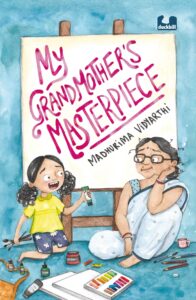
There’s one section in th book where Nini asks her Minima if she is drawing bhoots. Minima shakes her head and then draws a bhoot for her. Can you draw a bhoot? How about something you see around you like a box of paints?
Exploring vocabulary and drawing together is always fun, and we’ll see how well we can guess what the others draw for us on a shared screen!
Schools have Grandparents Day, and our book club will have something of the kind too. I would love for the children to show the others pictures of their grandparents and tell us a line or two about them. How many grandparents do they have? Do they meet their grandparents at all? What makes grandparents special?
Every child I’ve ever met has loved playing some version of being grown up. Whether they’re playing Teacher-Teacher or House-House, wearing a dupatta or spectacles, pretend games about being an adult are very much a part of childhood.
I’d love to explore this further with a small written exercise. How tall will they become? What will they do? I’ll give them a list of sentences to complete, sign and hide away, creating a little note to their future selves.
Registrations are closed for this reading programme. Watch out for the next ones on my workshop calendar!
New batches begin every alternate month. If you would like to receive email notifications about my programmes, please fill this form. Alternatively, follow me on social media – Facebook, Instagram and Twitter – for regular updates.

May 22, 2022
Greetings from Somewhere is a popular series of chapter books, and when I chose The Mystery of the Suspicious Spices for my book club, I hadn’t yet read it yet. The book I wanted was not available, and I just went with the idea that this one was popular and available. I knew I would, of course, read it well before my reading programme began.
And then, as I read it, I wondered if I wanted my book club to read it. It’s set in India and, simply put, doesn’t work.
The picture of a sari looks nothing like a sari.
There’s a section where an Indian character eats a paratha and wants to say that it is gross. He exclaims, ‘Sakala!‘
I had to look it up. And I discovered that Google translate had probably been used because yes, the word means ‘gross’, but in the context of gross weight!
How could I possibly read this at my book club?
And then, I began mulling over the fact that so many children I work with write stories about blue-eyed, blond Laura in Pennsylvania, not realising how problematic it is to set a story in a place you don’t know well. What better way to bring this into focus than with a book like this?
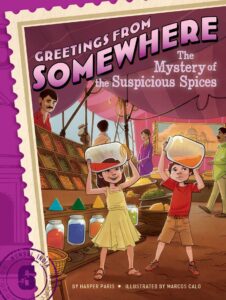
We made postcards when we read The Absolutely True Adventures of Daydreamer Dev, and Paati Goes Viral, andit was so much fun!
Greetings from Somewhere is all about travel too, but instead of postcards, we’ll make a greeting card this time, with an acrostic poem within.
As we read, I will ask the children to point out what doesn’t work for them, based on their knowledge of India. Have you or your parents ever seen an emerald green spice? Does coriander taste like oranges?
This will, I hope, lead the conversation towards writing what we know, and, equally, researching what we don’t.
What kinds of mysteries do the children think they can solve? I will give them a couple of simple “mysterious” puzzles and ask them how they think they would go about solving them. This promises to be exciting!
Registrations are closed for this reading programme. Watch out for the next ones on my workshop calendar!
New batches begin every alternate month. If you would like to receive email notifications about my programmes, please fill this form. Alternatively, follow me on social media – Facebook, Instagram and Twitter – for regular updates.

May 7, 2022
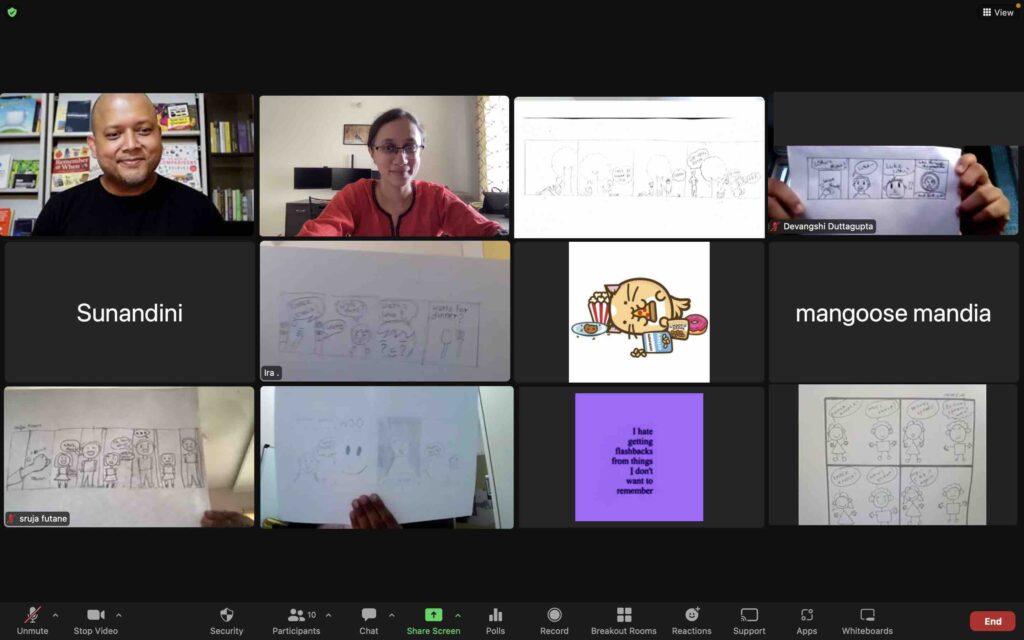
I’ve said it before, and I’m sure I’ll say it again. There’s nothing like inviting guests to my writing programmes. The energy, the fun, the enthusiasm … Can you believe that every participant (except me) managed to create a comic strip during the session?
Greystroke, an author, illustrator, filmmaker and entrepreneur, took us through the creation of a four-panel comic strip. I learned so much!
Among other things, we discussed the importance of pauses, something I mull over whenever I’m writing. Where would you pause in the telling of a joke? How do we create the perfect build-up before delivering a punchline? Each comic artist might choose a different place, and this leads to a variety of structures.

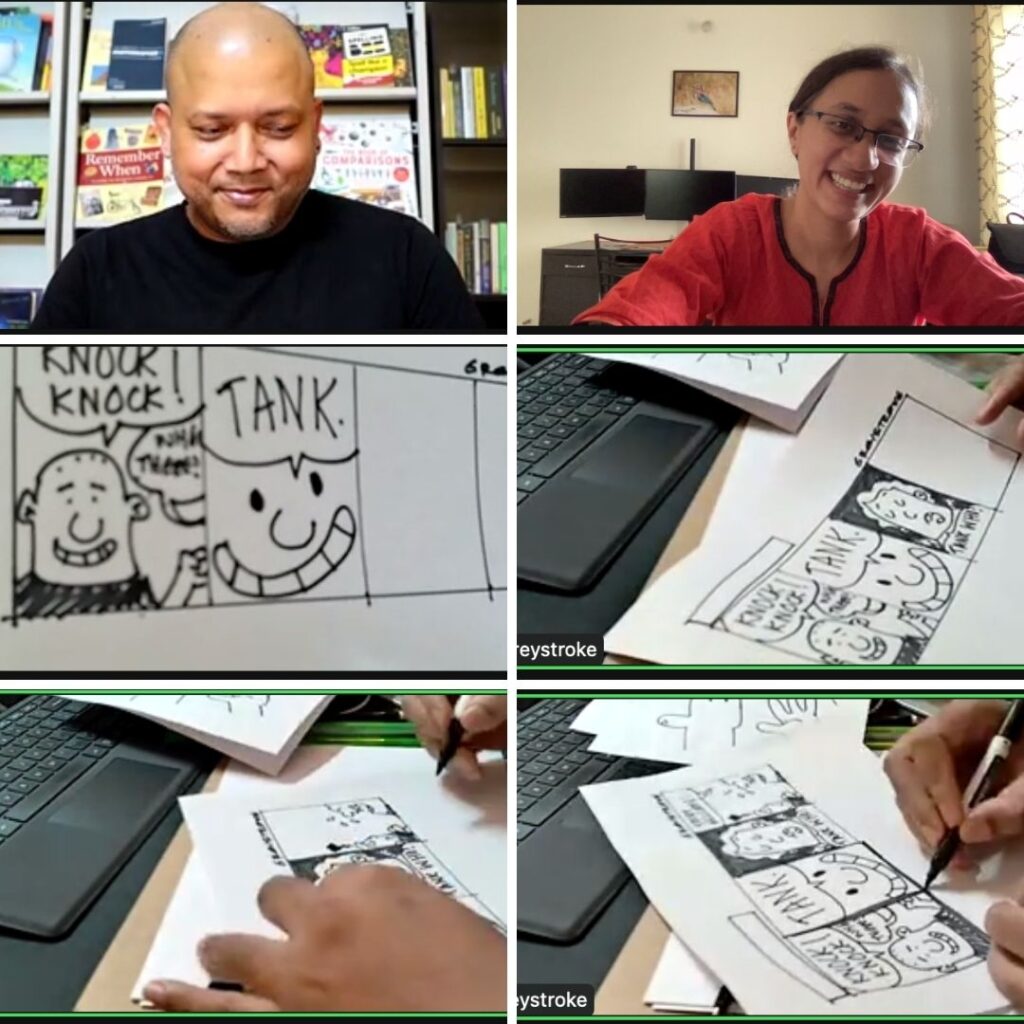
Tips and tricks to help draw characters and details, the visual appeal of a variety of perspectives, the similarities between a comic and a movie … the workshop was a treat from start to finish! One hour flew past, yes, but it’s incredible how much we were able to do during that hour.
The comic-making workshop was a guest session at my regular online creative writing programme. Visit my Workshop Calendar to find out about upcoming programmes.
If you would like to receive email notifications about other workshops and programmes, please fill this form. Alternatively, follow me on social media – Facebook, Instagram and Twitter – for updates.
March 29, 2022
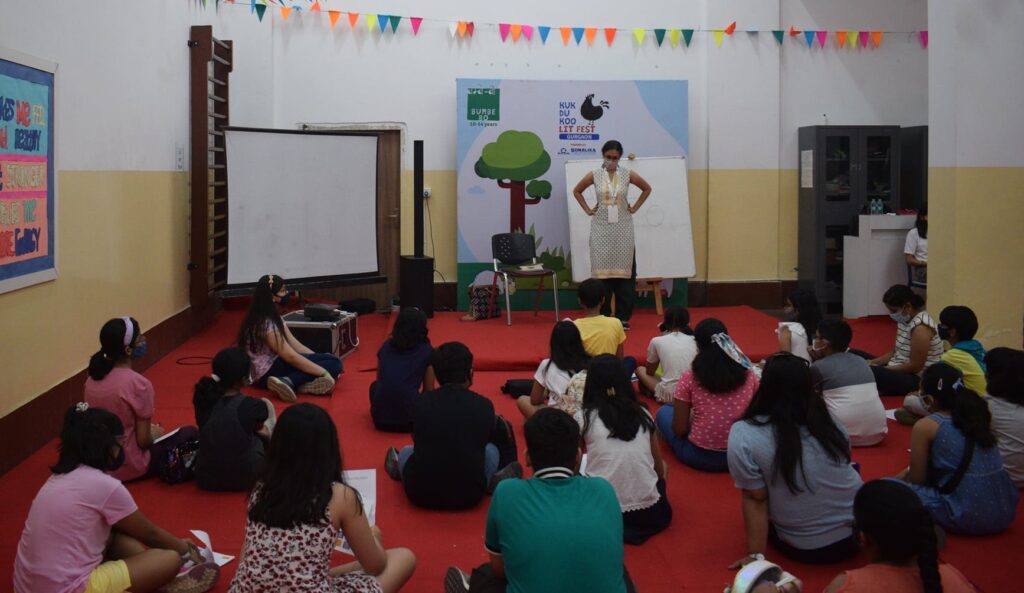
There’s nothing quite like the energy of a lit fest. Children running around, reading, getting excited about books … what more does a writer want?
My first session of the day was all about my middle-grade book, Sisters at New Dawn. Do you see the sheets of paper in the children’s hands? They’re lists of subjects children at New Dawn choose from. I asked the children to imagine they received these lists. What would they choose? I loved listening to all their responses, and all their additions to my subject lists!
But what made my session extra special is the girl in yellow right in the front. That’s Sunandini, and we finally took a picture together too. She’s been part of my online creative writing programme for the last two years now, and she lives in Kolkata, but she stayed back just for my session! Sunandini bought Sisters, read it one day in advance, and brought it for me to sign at Kukdukoo. She’s the very first online participant I’ve met in person, and it was such a joy to meet her!
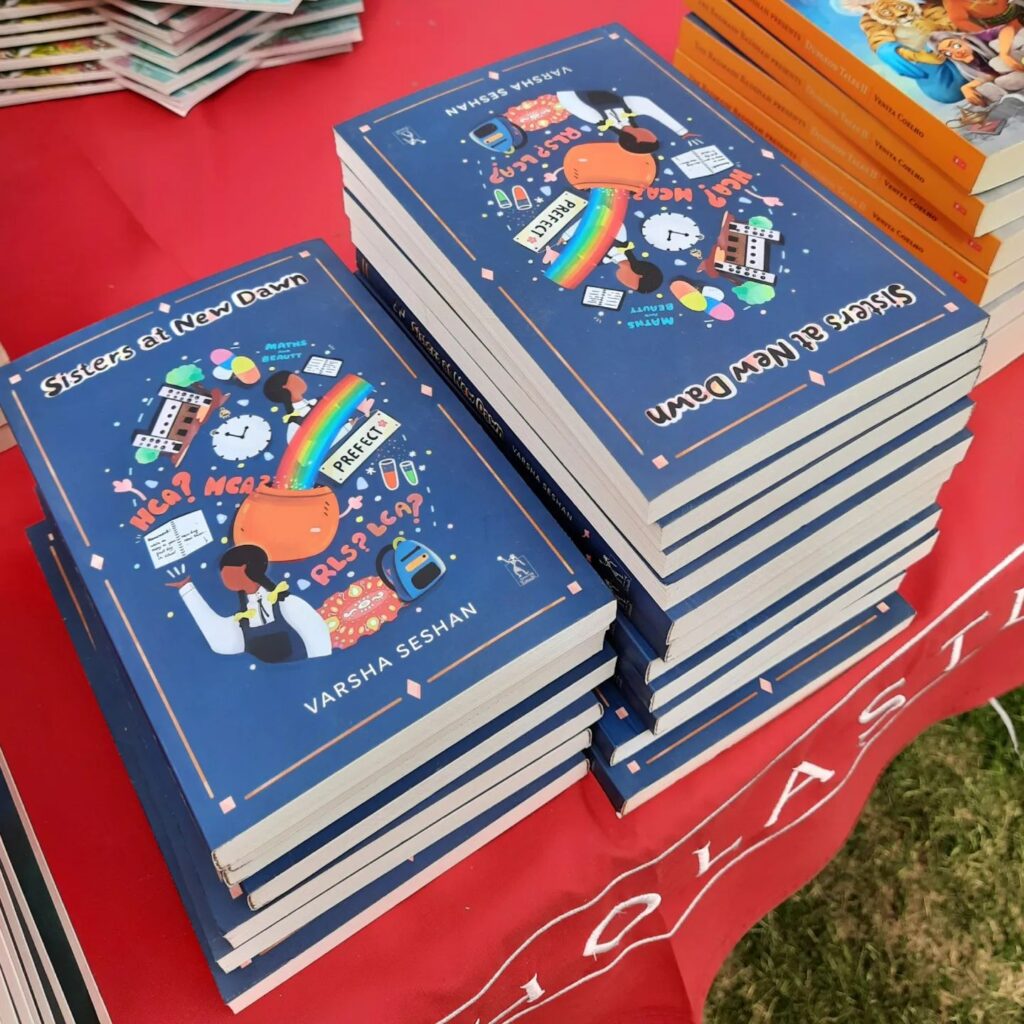
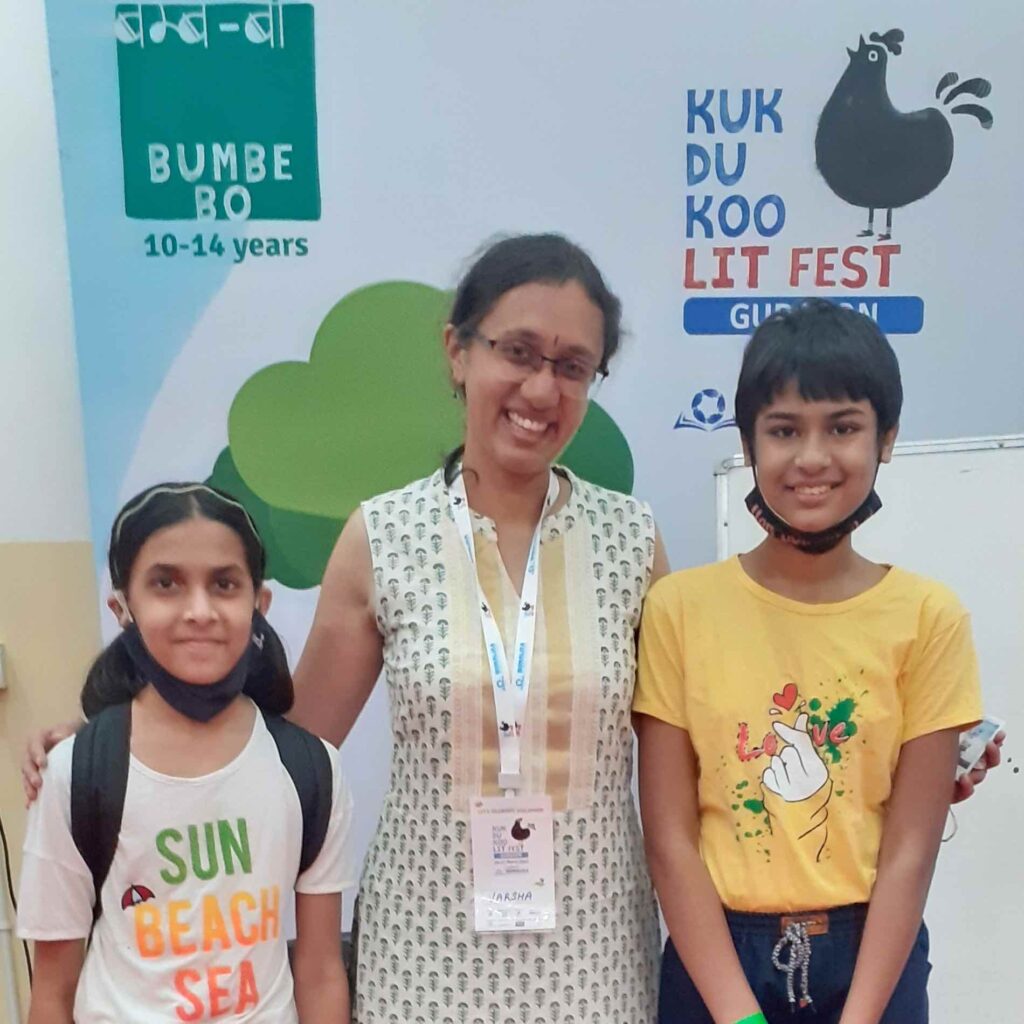
My second session was based on The Best Idea of All, and it was with littler ones, out on the field. As always, I was astounded by all their responses when it came to the question of conserving water and saving the world!
“We can use a sponge and bucket to wash a car.”
“We should collect rainwater in buckets.”
“Rainwater harvesting!”
“Bathe using a bucket, instead of taking a shower.”
We spoke of chemicals and making natural colours – and several of the children already knew how to make colours of their own!
In some ways, however, what made Kukdukoo even more special was all the people I met there, people I’ve interacted with online, people whose books I’ve read and reviewed, people whose videos I’ve watched … It was lovely! I bumped into Ramya Srinidhi, who told two stories from my Dragonflies, Jigsaws and Seashells for Scholastic India. I met Janaki Sabesh, Rohini Vij, Shibal Bhartiya, Paro Anand … It was such a treat!

I also took my books along for some them to sign. Here are a few special ones.
I read Bena’s Summer some time ago, and I was moved by the story. It’s such a beautiful, lyrical story, bursting with innocence and compassion. Of course I had to get my copy autographed!
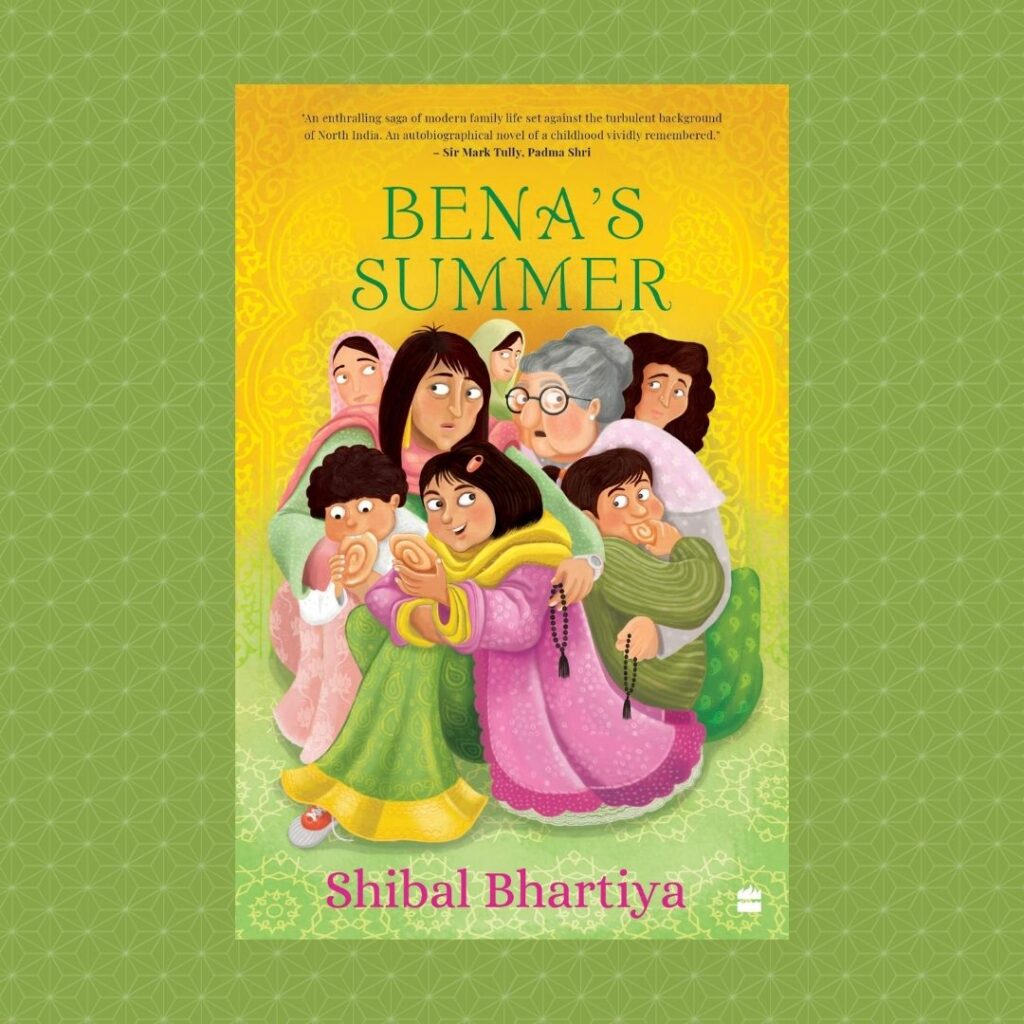

Many years ago, when I was about nine years old, I read Paro Anand’s very first book, Pepper the Capuchin Monkey. I took it along for her to sign for me, and I agree with what she’s written there. It was wow … just wow.


And while I was at it, I also asked her to autograph A Very Naughty Dragon, which we read at my book club some time ago. I told her about everything we did with it, the way the children explored other endangered animals and the discussions we had.
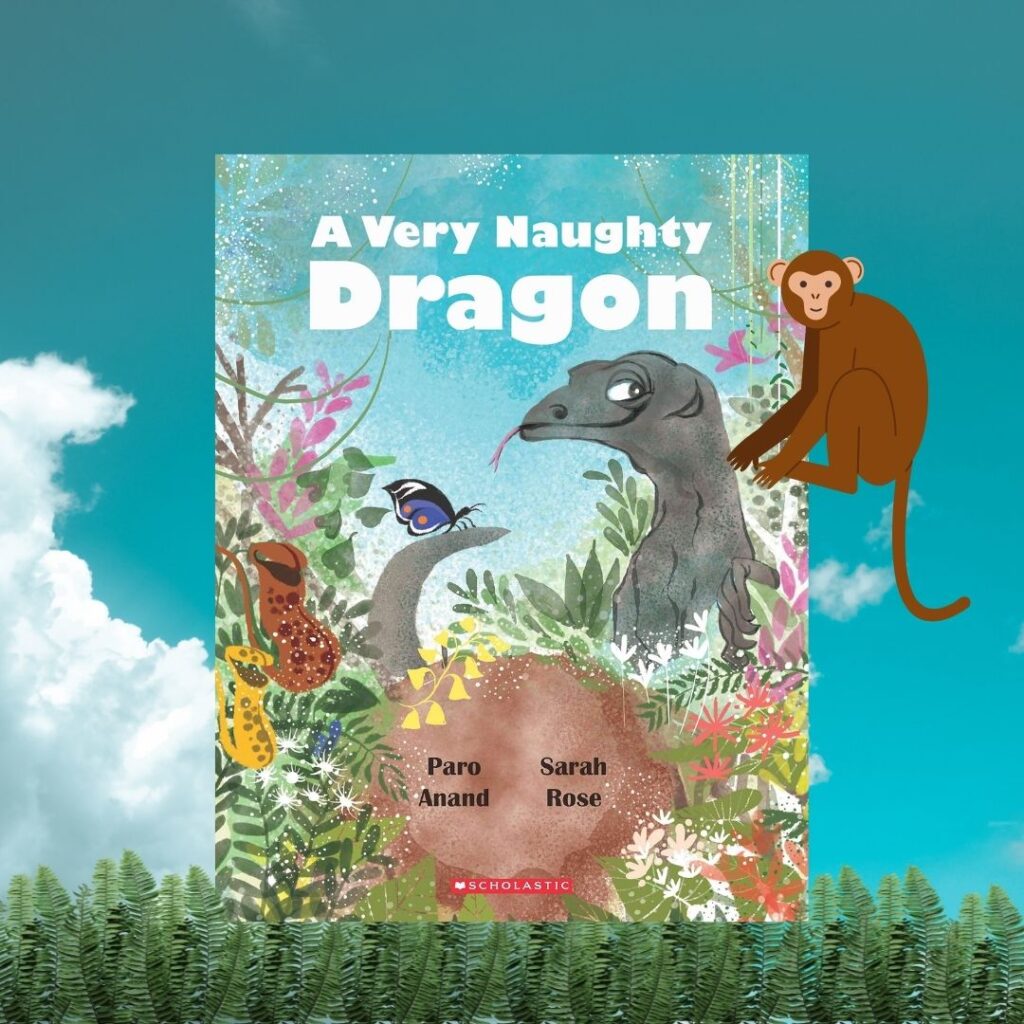
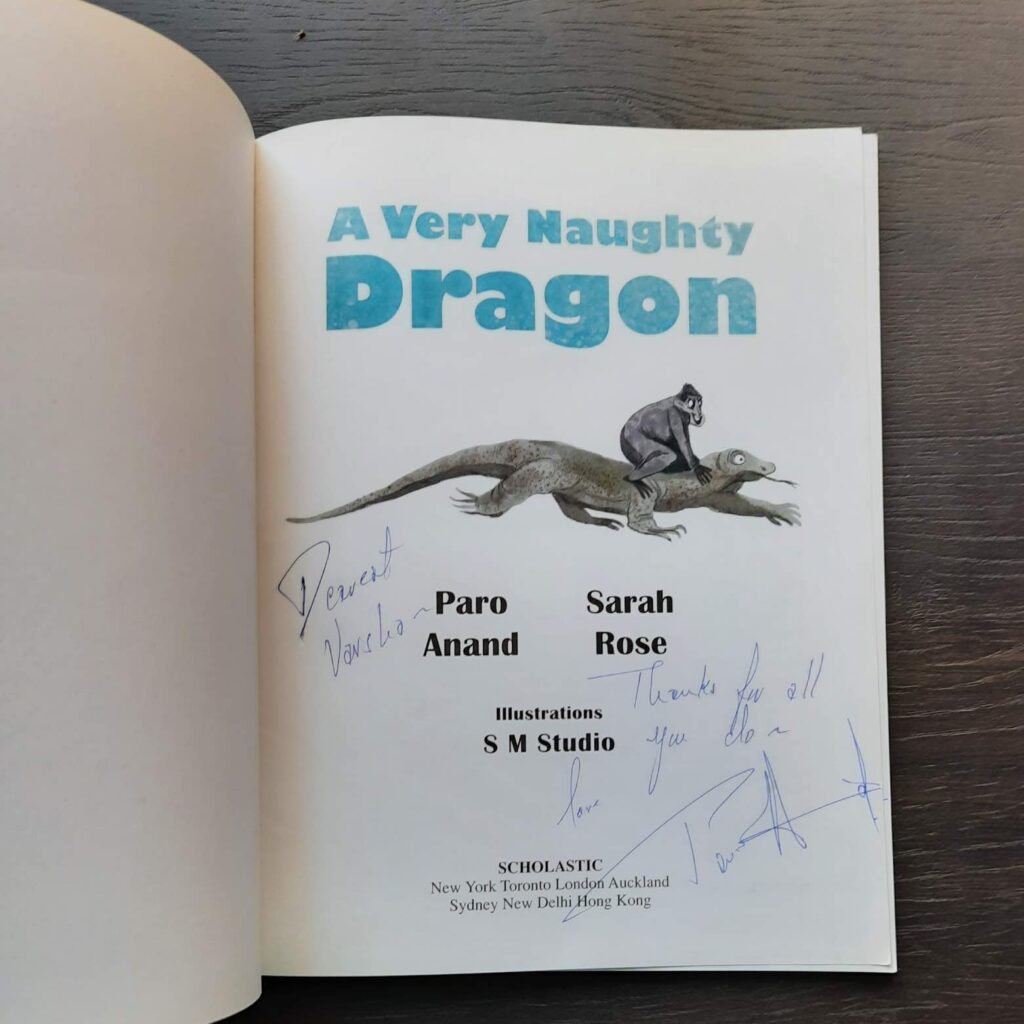
The most surreal moment, however, was when she bought a copy of Sisters at New Dawn and asked me to sign it for her. I wish I were better at thinking of taking photographs!
Kukdukoo 2022 was my first in-person lit fest since 2019. It was full of energy, laughter and enthusiasm. Here’s to many more!
March 14, 2022
Ghosts Don’t Eat is the third of Anushka Ravishankar’s books that we’re reading at my online reading programme, and it promises to be just as much fun! We read Moin and the Monster at my book club for slightly older readers and the first of the Zain and Ana books, At Least a Fish, at an earlier edition of my book club for ages seven and eight.
Ghosts Don’t Eat is a hilarious book. I love children with good, earnest intentions, never mind what happens next. For instance, Ana wants to investigate the ghost in her neighbour Nikhil’s house, so of course she needs Zain to create some sort of distraction. And what’s the first idea that comes to mind? Start a fire! Is that the best idea? Um …
I’m waiting to read Ghosts Don’t Eat with my book club!
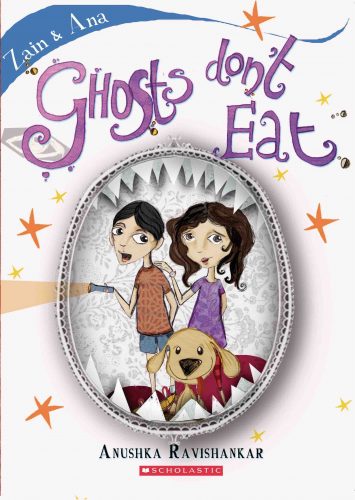
Ana loves words. Insufferable. Namby-pamby. Alibi.
What better introduction to a word game? I’d love to do all kinds of word games with the children – from a timed word-building game to unscramble. It promises to be fun!
Zain and Ana want to do a scientific experiment that might just win them a Nobel. They want to establish which part of their brain hurts when they exercise it in different ways.
I love linking reading to other activities, and so, we’ll talk about experiments the children would like to conduct. I might even introduce them to the Ig Nobel prize! If we have the time, we’ll do a little scientific activity of our own.
Until the very end of the book, we’re kept wondering what exactly Zain and Ana are going to give Nikhil. It’s not a dog, we know that much. And Zain is nervous about how good an idea it is to give Nikhil this animal. Hmm. What could it be? What animals would make for unusual pets?
